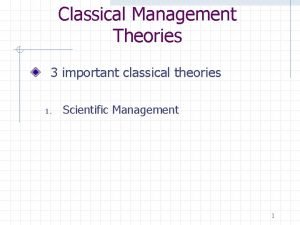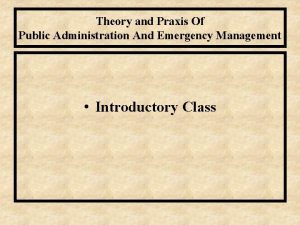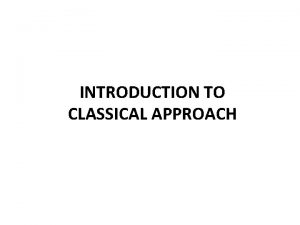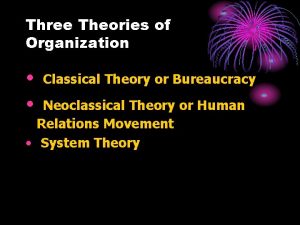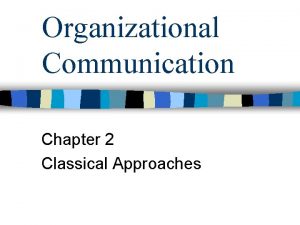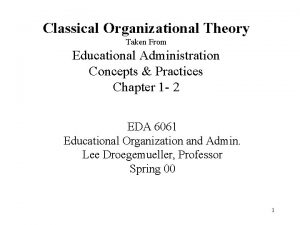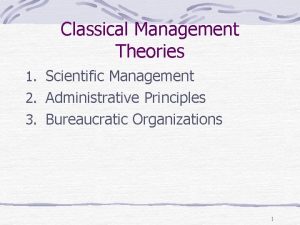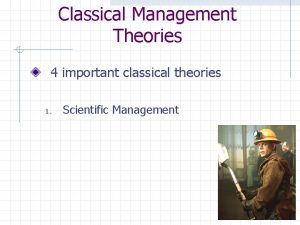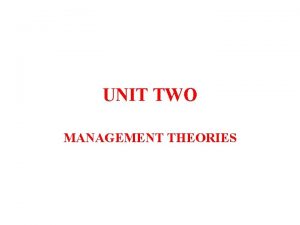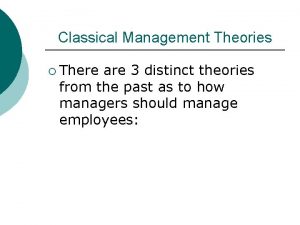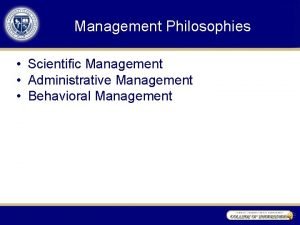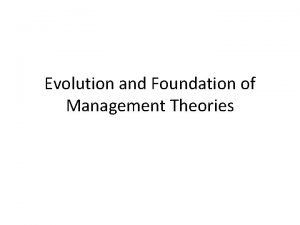Organization Theories Classical Theory Scientific Management theory Administrative
















- Slides: 16

Organization Theories

� Classical Theory - Scientific Management theory - Administrative Management Theory - Theory of Bureaucracy � Human Relation approach ( Hawthorne experiments) � System theory � Contingency Theory Organization theories

Given by Frederick W. Taylor Principles of scientific management : �Substituting research science rules for rules of thumb �Harmony in Group action �Cooperation �Maximum output in place of restricted output �Scientifically select, train, teach and develop employees Scientific Management theory

Main features: � Separation � Functional of planning from doing function foremanship � Standardize � Work fair day’s work study -Method study - Motion study -Time study - Fatigue study Scientific Management theory

�Rate setting �Standardization �Scientific selection & training �Financial incentives �Mental Revolution Scientific Management theory

Given By Henry Fayol 1. Division of work 2. Authority & Responsibility 3. Discipline 4. Unity of Command 5. Unity Of direction 6. Subordination of individual interest to Group interest Administrative theory

7. Remuneration of personnel 8. Centralization 9. Scalar Chain 10. Order 11. Equity 12. Stability of tenure 13. Initiative 14. Esprit de Corps Administrative theory contd…

Given by Max Weber �Division of Labor with highly skilled employees in each position �Consistent �Hierarchy organization rules and procedures of authority/chain of command �Impersonality of interpersonal relationships �Employment/Advancement based on competence Bureaucracy theory


Hawthorne experiments conducted by Elton Mayo � Illumination � Relay experiment assembly test room experience � Mass interviewing programme � Bank wiring observation room experiment Human relation approach

�Organizations are social organizations �Informal group exists with formal groups �Production norms decided by social norms not by physical capacity �Money not a sole motivator �Informal leader exists �Friendly supervision �Workers prefer cordial relationships Findings of Hawthorne experiments

The Systems Approach �System Defined ◦ A set of interrelated and interdependent parts arranged in a manner that produces a unified whole. �Basic Types of Systems ◦ Closed systems � Are not influenced by and do not interact with their environment (all system input and output is internal). ◦ Open systems � Dynamically interact to their environments by taking in inputs and transforming them into outputs that are distributed into their environments.

The Organization as an Open System

�Composed of subsystems �Components are interrelated �Environment awareness �Feedback �Cyclical character �Balance of maintenance & adaptation activities �Self regulatory mechanism Characteristics of open system:

Implications of the Systems Approach �Coordination of the organization’s parts is essential for proper functioning of the entire organization. �Decisions and actions taken in one area of the organization will have an effect in other areas of the organization. �Organizations are not self-contained and, therefore, must adapt to changes in their external environment.

The Contingency Approach Defined ◦ Also sometimes called the situational approach. ◦ There is no one universally applicable set of management principles (rules) by which to manage organizations. ◦ Organizations are individually different, face different situations (contingency variables), and require different ways of managing.
 Behavioral management theory
Behavioral management theory The classical theory of management
The classical theory of management Classical theories of management
Classical theories of management Administrative theory and praxis
Administrative theory and praxis Meaning of classical approach
Meaning of classical approach Scope of decision making
Scope of decision making Six decision making steps
Six decision making steps Classical theory of organization
Classical theory of organization How is a scientific law different from a scientific theory?
How is a scientific law different from a scientific theory? Classical theories of organizational communication
Classical theories of organizational communication Classical theories of international trade
Classical theories of international trade Classical theory in educational management
Classical theory in educational management Neoclassical organization theory
Neoclassical organization theory Keynesian and classical theory
Keynesian and classical theory Keynesian recession
Keynesian recession Information gathered during an experiment
Information gathered during an experiment Father of the scientific management
Father of the scientific management


